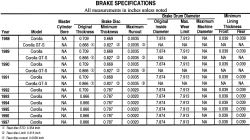
The brake fluid reservoir is located on top of the master cylinder. While no special procedures are needed to fill the fluid, the reservoir cap and surrounding area must be wiped clean of all dirt and debris before removing the cap. The slightest dirt in the fluid can cause a system malfunction. Use only DOT 3 fluid from an unopened container. Use of old, polluted or non-approved fluid can seriously impair the function of the system.
BLEEDING THE SYSTEM
Bleeding is performed in the usual manner, using either a pressure bleeder or the 2-person manual method. If a pressure bleeder is used, it must be of the diaphragm type with an internal diaphragm separating the air chamber from the fluid. Tighten each bleeder plug to 74 inch lbs. (8 Nm).
Always begin the bleeding with the longest brake line, then the next longest, and so on. If the master cylinder has been repaired or if the reservoir has been emptied, the master cylinder will need to be bled before the individual lines and calipers. During any bleeding procedure, make certain to maintain the fluid level above the MIN line on the reservoir. When the bleeding procedure is complete, fill the reservoir to the MAX line before reinstalling the cap.
See Figure 1

 |  |
Fig. Fig. 1: Brake Specificaitons